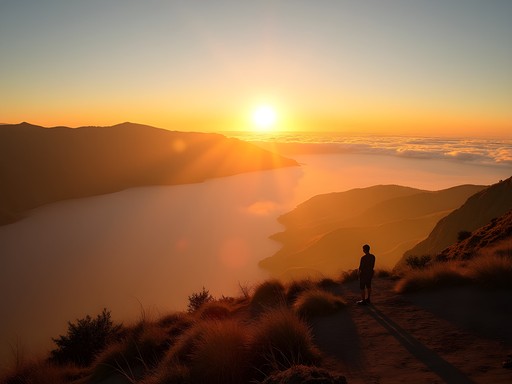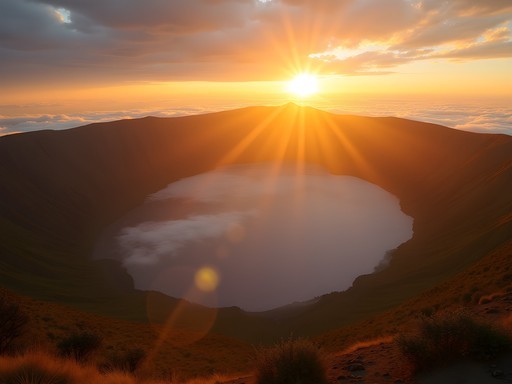Disclosure: This article contains affiliate links. We may earn a commission from purchases at no extra cost to you, which helps our travel content.
The first light breaks over the rim of Ngorongoro Crater, casting golden hues across a landscape that feels prehistoric in its raw beauty. Below, the caldera teems with life – lions lounging in tall grass, elephants traversing ancient paths, and flamingos creating pink brushstrokes against alkaline lakes. As a filmmaker who has documented wildlife across six continents, I can state with absolute certainty: few locations on Earth offer the photographic potential of this Tanzanian wonder. This collapsed volcanic caldera presents a 260 square kilometer stage where Africa's most iconic species perform daily, unaware of their audience. Join me as I share how to capture the perfect frame in this natural amphitheater of wild splendor.
Planning Your Photographic Expedition
Ngorongoro demands thoughtful preparation that balances photographic ambition with practical realities. I've learned through multiple visits that the crater's microclimate can shift dramatically throughout the day. Early mornings bring mist that softens light and creates atmospheric depth, while midday offers clarity but harsh contrast.
I recommend booking accommodation at one of the lodges perched along the crater rim, allowing for first-light descent when animals are most active. The Swarovski Optik NL Pure 10x42 have proven invaluable for scouting distant subjects before committing to a shooting position. Their exceptional light gathering capability helps identify potential compositions even in the dim dawn light.
Consider hiring a private safari vehicle rather than joining group tours. The flexibility to position yourself optimally for light and composition rather than accommodating casual tourists is worth every penny for serious photographers. Work with operators who understand photographers' needs – I've had tremendous success with guides who were willing to wait patiently in one location rather than rushing between animal sightings.

💡 Pro Tips
- Book accommodation on the crater rim for early morning access
- Hire a private safari vehicle with an experienced photography guide
- Plan for at least three full days in the crater to account for changing conditions
Essential Gear for Crater Photography
The unique challenges of Ngorongoro demand specialized equipment. Dust is your constant companion, making weather-sealed gear non-negotiable. My primary kit includes a full-frame mirrorless body with a 100-500mm telephoto for wildlife and a 24-70mm for environmental contexts.
Dust protection becomes critical in this environment. I wrap my gear in silicone protective covers when not in use, and carry a sensor cleaning kit for inevitable dust spots. After filming a documentary segment on black rhinos here last year, I discovered my sensor looked like a star map despite religious use of lens caps.
Power management requires attention as charging opportunities are limited during full-day crater excursions. The power station has become my constant companion, providing enough capacity to recharge camera batteries and other devices between game drives. It's surprisingly compact given its capacity and has weathered the African elements admirably.
Finally, invest in a quality bean bag support rather than a traditional tripod. Vehicle-based photography benefits from this flexible platform that absorbs micro-vibrations while allowing quick repositioning as wildlife moves.

💡 Pro Tips
- Use silicone covers to protect gear from fine dust
- Pack double the battery capacity you think you'll need
- Bring a laptop with external SSD for daily backups of irreplaceable images
Mastering Light in the Caldera
The crater's topography creates unique lighting conditions that can make or break your images. The high walls cast dramatic shadows that sweep across the landscape as the day progresses, creating natural spotlighting effects that can elevate wildlife portraits from documentary to art.
During my filming for 'Realms of Refuge' documentary series, I discovered that positioning subjects between your lens and the crater wall during golden hour creates a luminous rim lighting effect that separates animals from their background with almost ethereal quality. This technique works particularly well with elephants and buffalo, whose distinctive silhouettes gain sculptural dimension.
The crater floor's open expanses mean weather systems are visible from miles away. I've learned to embrace approaching storms rather than retreat from them. Some of my most compelling images feature wildlife against brooding skies, moments before rainfall. The weather monitoring device has proven invaluable for predicting these dramatic weather transitions with enough precision to prepare equipment and positioning.
For the technically minded, I've found exposure compensation of +2/3 to +1 stop generally necessary when shooting dark-skinned animals like elephants and buffalo against the bright crater floor, while zebras and reflective water scenes often require -1/3 to -2/3 compensation to retain highlight detail.

💡 Pro Tips
- Position yourself with the sun at your back during early morning and late afternoon
- Use graduated ND filters to balance bright skies with shadowed crater floor
- Look for natural frames created by acacia trees to add depth to wildlife portraits
Behavioral Anticipation: The Cinematographer's Advantage
My background in wildlife filmmaking has taught me that understanding animal behavior is the true secret to exceptional photography. The crater's concentrated wildlife means interactions are frequent and dramatic – if you know what to look for.
Predator-prey dynamics create the most compelling visual narratives. When filming lions in Ngorongoro last summer, I noticed subtle shifts in zebra herd formation that telegraphed the presence of predators long before the lions themselves became visible. These behavioral cues now inform my positioning decisions, allowing me to anticipate rather than react to unfolding drama.
The advanced field guide has been my constant companion, dog-eared and annotation-filled from countless field expeditions. Understanding that hippos return to water along the same paths each morning or that hyenas communicate hunting intentions through specific vocalizations transforms your approach from random chance to informed anticipation.
I recommend maintaining a behavioral journal alongside your technical shooting notes. Record patterns in animal movement, feeding times, and territorial displays. My own journals have become invaluable references for subsequent visits, with location-specific insights that no general wildlife guide could provide.

💡 Pro Tips
- Study animal behavior patterns before your trip to anticipate key moments
- Watch for birds taking flight as an early warning system for predator movement
- Learn to read the landscape for natural wildlife corridors where animals are likely to appear
Ethical Photography in a Fragile Ecosystem
The privilege of photographing Ngorongoro comes with profound responsibility. This UNESCO World Heritage site faces increasing pressure from tourism, climate change, and human-wildlife conflict. As visual storytellers, we must consider our impact and the narratives we perpetuate.
My approach has evolved considerably since my first visit a decade ago. I now prioritize minimal disturbance over perfect positioning. The silent shooting mode helps reduce the intrusive mechanical sounds that can alter natural behavior, particularly with skittish species like the critically endangered black rhino.
Working with Maasai guides has transformed my understanding of this ecosystem. Their generational knowledge provides context impossible to gain through conventional research. During my last expedition, my guide Lenana identified subtle habitat changes indicating shifting migration patterns that informed both my cinematography and my understanding of climate impacts.
I've also embraced remote camera technologies where appropriate. The camera trap system has allowed me to document shy nocturnal species without human presence. These images offer scientific value beyond their artistic merit, contributing to monitoring efforts when shared with conservation organizations working in the crater.

💡 Pro Tips
- Maintain greater distance than you think necessary – modern telephoto lenses make this possible without sacrificing image quality
- Never pressure guides to pursue stressed animals or approach beyond comfortable distances
- Share meaningful images with conservation organizations to support their documentation efforts
Final Thoughts
As the sun sets behind the crater rim, casting long shadows across this natural wonder, I'm reminded that our photographs serve as both art and testament. Each frame captured in Ngorongoro documents a fragile ecosystem at a specific moment in time – a visual record increasingly precious as climate change and human encroachment reshape these landscapes. The techniques I've shared go beyond technical mastery to embrace the storytelling potential inherent in wildlife photography. The most compelling images emerge when technical precision meets behavioral understanding and ethical awareness. Whether this is your first photographic expedition to Tanzania or you're returning to deepen your portfolio, approach the crater with reverence and patience. Allow yourself the luxury of stillness – of waiting for light, behavior, and composition to align. And when you return home, share your images not just as personal achievements but as windows into a world worth protecting. The true measure of our work in places like Ngorongoro isn't the technical perfection of our photographs, but their power to inspire conservation of the wild subjects that grant us their fleeting presence before our lenses.
✨ Key Takeaways
- Position yourself strategically using the crater's unique topography and light patterns
- Understanding animal behavior patterns leads to anticipating rather than reacting to photographic moments
- Ethical considerations should guide all photography decisions in this sensitive ecosystem
- Work with knowledgeable local guides who understand both wildlife and optimal photography conditions
📋 Practical Information
Best Time to Visit
June to October (dry season) for best visibility and animal concentration around water sources
Budget Estimate
$800-1200 per day including private vehicle, professional guide, and luxury lodge accommodation
Recommended Duration
5-7 days minimum to account for weather variations and maximize photographic opportunities
Difficulty Level
Moderate To Challenging Due To Early Starts, Long Days, And Technical Photography Requirements
















Comments
Taylor Moreau
Brilliant guide, Avery. I was at Ngorongoro last year leading a photography workshop, and your tips on working with the crater's unique lighting conditions are spot on. The contrast between the shadowed crater walls and the sunlit plains can be challenging. One additional tip for readers: bring a polarizing filter to cut through haze and enhance those dramatic clouds that often form over the crater. Also, don't forget to occasionally put the camera down and simply absorb the majesty of this place - some experiences are best captured by memory alone.
Avery Gordon
Thanks, Taylor! Great point about the polarizing filter - absolute game-changer for those crater landscapes. And I couldn't agree more about putting the camera down sometimes. Some of my most vivid memories are when I just sat and watched a lion family for 30 minutes without taking a single shot.
wanderguide7062
This whole thread is getting saved for my trip planning! @Taylor - any recommendations for specific viewpoints around the crater rim for landscapes?
Taylor Moreau
The western rim near Lemala descent road has spectacular morning views when the light hits the crater floor. For sunset, head to the eastern viewpoints near Sopa Lodge. Both offer different perspectives of how light plays across the landscape.
roamway
Those rhino shots are incredible! What lens did you use?
Avery Gordon
Thanks! I used my telephoto zoom for most of the wildlife shots. The crater's open landscape lets you spot animals from far away, but a good zoom is still essential for those intimate portraits.
roamway
Good to know! Been debating upgrading my lens before my safari. That one looks perfect.
wanderguide7062
This guide is EXACTLY what I needed! Heading to Tanzania in December and Ngorongoro is at the top of my list. I've been stressing about getting the right shots without the typical touristy vibe. That section on behavioral anticipation is gold - never thought about studying animal patterns before shooting. Did you find early morning really was the best time? Wondering if I should book multiple entries to catch both dawn and dusk lighting.
Taylor Moreau
Early morning is absolutely worth it! I've photographed the crater three times now, and dawn provides that magical golden light that makes wildlife pop against the landscape. If your budget allows, I'd recommend both dawn and dusk entries - they offer completely different moods. Dawn tends to have more active predators, while dusk often presents more dramatic skies.
wanderguide7062
Thanks so much for the advice! Definitely going to book both then. Can't wait!
Sage Dixon
Your post brought back so many memories! I was in Ngorongoro last year and that morning descent into the crater is something I'll never forget. The way the mist hangs over the grasslands as the sun rises... pure magic. One tip I'd add for photographers - bring a beanbag support for your camera if shooting from a vehicle. The roads can get bumpy and it saved my shots countless times. Also, the rhinos were incredibly shy when I visited - we had to use my spotting scope to get decent views before attempting photos. Did you have better luck getting close to them?
Avery Gordon
Great point about the beanbag support, Sage! I should've mentioned that. And yes, the rhinos were distant for us too - we got lucky on day three when one crossed about 80 meters from our vehicle. Our guide said it was unusually close. Most of my rhino shots were with a 600mm + 1.4x teleconverter.
Sage Dixon
80 meters is practically a close encounter with those shy giants! Your teleconverter setup sounds perfect. Did you camp at the rim? Those sunrise views from Sopa Lodge were worth the early alarm clock!
Avery Gordon
We split our time between Sopa and Ngorongoro Serena - both had incredible views but slightly different perspectives of the crater. Those pre-dawn wake-up calls were brutal but so worth it!
summerace
This is exactly what I needed! I'm heading to Tanzania in October. Did you find early morning or afternoon better for spotting the big cats? Also wondering if a 200mm lens would be enough or if I should rent something longer?
Avery Gordon
Early mornings were magical for cats! We found lions most active around 6:30-8am. Regarding lenses, a 200mm will work for many shots, but I'd honestly recommend at least a 100-400mm for flexibility. The crater floor is vast and sometimes the action is distant.
summerace
Thanks so much! Guess I'll be renting a longer lens then. Can't wait to try catching that golden morning light!
TanzaniaLover
Best Ngorongoro guide I've seen! Bookmarking this for my trip in January.
Jean Wells
Having photographed in Ngorongoro three times now, I can attest to everything Avery mentions about the light conditions. The crater creates its own microclimate that can shift dramatically within hours. One technique I've found valuable is bracketing exposures, especially during midday when the contrast between shadows and highlights becomes extreme. The section on approaching hippo pools cautiously is particularly important - I've witnessed photographers getting too close and creating dangerous situations. For solo travelers considering this trip: while most focus on the Big Five, don't overlook the incredible bird photography opportunities. The flamingos along the alkaline lakes create stunning compositional elements against the crater walls.
roamlover
Jean, did you stay at the rim or down in the crater area? Trying to decide where to book!
Jean Wells
I've done both. Rim lodges give you those spectacular sunrise views over the crater that are worth the premium. But staying outside the conservation area is fine too - just add 30-45 minutes to your morning drive time to reach the descent road.
travelvibes
Going there next month! Is a full-frame camera necessary or will my crop sensor be ok?
wanderlustwanderer
Not Avery, but I used a crop sensor in Serengeti last year and got amazing shots! The extra reach was actually helpful for wildlife.
Avery Gordon
Wanderlust is right! A crop sensor works perfectly fine - sometimes even better for distant wildlife. Just bring plenty of memory cards and a good zoom lens. The crater light is fantastic so you'll get great results regardless!
travelvibes
Thanks both! That's a relief - was worried I'd need to upgrade before the trip!
winterone
Bookmarking this for my trip next year! Those dust management tips are gold!
Sarah Powell
Excellent guide, Avery! I was in Ngorongoro last year and can confirm your behavioral anticipation tips are spot-on. I'd add that spending an extra day in the crater can make all the difference - my best shots came on day two when I wasn't rushing and could patiently wait for those perfect moments. For anyone heading there, I found my telephoto zoom absolutely essential for those distant wildlife shots while maintaining sharpness. The crater's vastness means you'll often spot amazing scenes far away, especially the big cats. One question: did you find early morning or late afternoon better for capturing the elephants? I had mixed results with their movement patterns.
Avery Gordon
Great point about the extra day, Sarah! For elephants, I consistently had better luck in late afternoon when they gathered around the marshes. Mornings were hit-or-miss depending on the season. Did you visit during wet or dry season?
Venture X
Premium card with 2X miles, $300 travel credit, Priority Pass